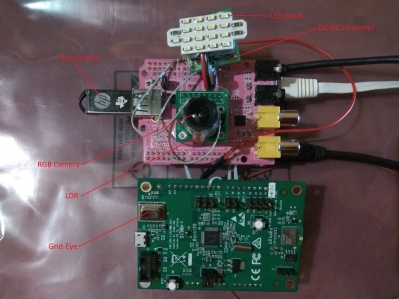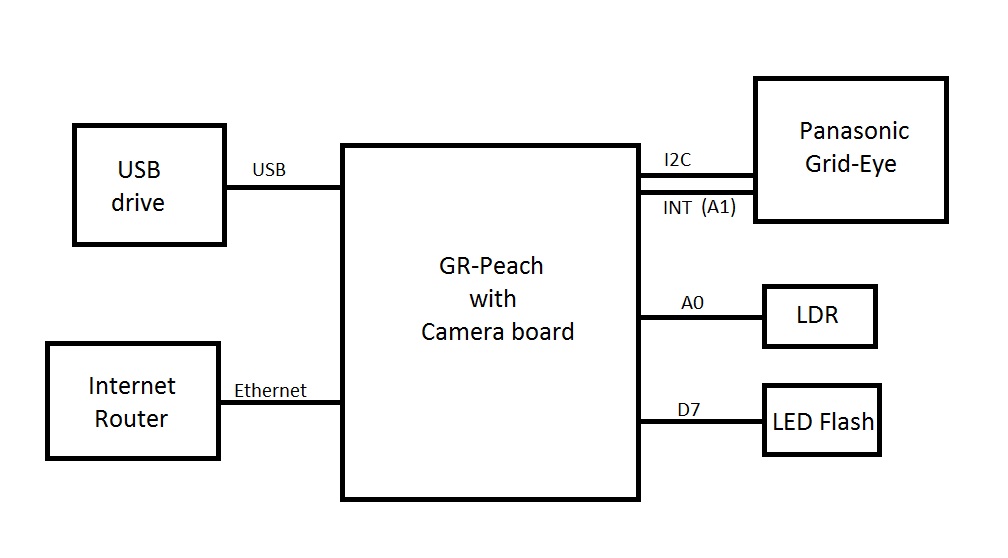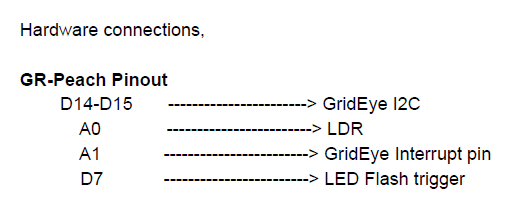Title:Smart thermal surveillance camera
Displayed Name:Ashwini Upadhya

| Concept / Overview |
|---|
| Smart surveillance camera available in the market today are capable of detecting motion and reporting it to the user via an email or mobile app notifications. The principle of motion detection is simple. Current image is compared with previous image and if change in pixel values is greater than threshold, notification is sent. This actually is not smart enough. A simple curtain movement in a room can trigger a notification push which is nothing but a false alarm to the user. Idea is to make these cameras smarter and more accurate in detecting intruder. |
Project Abstract Details
My idea is to build a smarter camera by detecting living beings using a thermopile array sensor and a webcam which are connected GR-PEACH. A thermopile array sensor consists of an array of infrared sensors which is used to read heat signature. Panasonic's grid-eye is one such sensor with 8x8 IR pixels and it has a evaluation kit with arduino shield form factor(https://eu.industrial.panasonic.com/grideye-evalkit) which fits into GR-PEACH's connectors. I2C is the interface for communication. An USB webcam is connected to GR-PEACH for capturing RGB image once a living being is detected by grid-eye. This captured image is then sent to pre-defined user's gmail account using Temboo(https://temboo.com/) framework over WiFi. For WiFi connectivity, an ESP8266 module is connected to GR-PEACH via UART. Temboo framework provides an interface to communicate with Twitter, Google services, Dropbox etc., So this image notification can be extended to use any services supported by Temboo framework. The power consumption of this system can be optimized by changing core clock frequency dynamically. For grid-eye frame grab, CPU can run at lower frequency and for image grab and sending it over WiFi, CPU frequency can be increased to max limit. For software support using mbed stack for peripheral communication(USB host, I2C, UART) will reduce the project completion time by great deal.
Hardware


Software
Software Architecture:
We have used following libraries from mbed:
1. mbed HAL for GR-Peach
2. GR-Peach camera-in
3. USB-Host Mass storage device
4. mbed RTOS
5. Ethernet
6. NTP client
7. IFTTT
Apart from these, we have written a bare minimum library for Grid-Eye.
Upon bootup, GR-Peach configures GridEye with threshold and to generate interrupt whenever temperature recorded by one or more pixel is more than the threshold. Interrupt is attached with a callback to “notify” image_capture thread to capture realtime image. After this, using NTP client the internal RTC of GR-Peach is updated with IST time. This is used while storing images.
Filename of these images are timestamps fetched using RTC, then USB MSD host is initialized, and the main program creates two threads, one for capturing images, second for reading LDR analog values once in every 15 mins. Image_capture thread captures realtime image using CMOS camera and notifies main thread to store captured image. Image stored will be in BMP
format. This continues till INT line from GridEye is asserted. Before capturing image LED flash is switched on when light conditions are not good. Check for light condition happens every 15mins using LDR. After storing image on to USB drive, main thread updates IFTTT cloud parameter.
This event is sent to user by sending an email to user about event occurrence using gmail.
Project Conclusion
This project has great improvements over commercially existing smart surveillance camera. This project avoids false alarm to user and provides energy efficient yet powerful system.
Finalist on GR-PEACH design contest in India 2016

